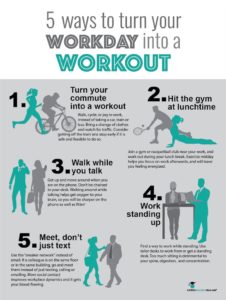Whether you’re back in the office or working remotely from home, it can be a challenge to fit exercise into a busy day.
That’s why our Workday Workout poster is an effective education tool to remind everyone that there are ways to fit fitness into your life, no matter where or how much you work.
This the perfect topic for a workplace class. In addition to talking about the strategies outlined on the poster, you can tailor your discussion to the time of year or specific challenges your audience faces.
Here are some examples:
- Holidays: Brainstorm strategies to keep moving even when you’re busier than ever.
- Covid & Flu: Talk about how to stay safe at the gym by properly disinfecting equipment and give a refresher on best handwashing practices.
- Getting Outside: Encourage everyone to do some exercise outside in nature for the mental health benefits and the vitamin D boost.
- Staying Inside: Explore easy options for those who can’t get outside, like exercise videos on YouTube.
- Hydration: Remind everyone about the importance of drinking enough water before, during, and after exercise.
Even long-time exercisers will appreciate new ideas for making movement part of their workday!
By Hollis Bass, MEd, RD, LD
New Handout: Workouts for Workdays





